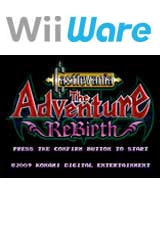| Castlevania: The Adventure ReBirth | |
|---|---|
 Cover art | |
| Developer(s) | M2 |
| Publisher(s) | Konami |
| Director(s) | Toshiyasu Kamiko Akihiro Minakata Keisuke Koga |
| Producer(s) | Koji Igarashi |
| Designer(s) | Keisuke Koga |
| Composer(s) | Manabu Namiki |
| Series | Castlevania |
| Platform(s) | WiiWare |
| Release | |
| Genre(s) | Action, platform |
| Mode(s) | Single-player |
Castlevania: The Adventure ReBirth [a] is a 2009 action-platform game developed by M2 and released by Konami for the Wii as a WiiWare title. It is a remake of the 1989 Game Boy title Castlevania: The Adventure and is the third game in M2's ReBirth series, following Gradius ReBirth and Contra ReBirth . The setting of the game is a century before the original Castlevania title, where the player controls an ancestor of Simon Belmont named Christopher Belmont, who must defeat the vampire Dracula. [4]
